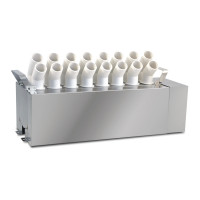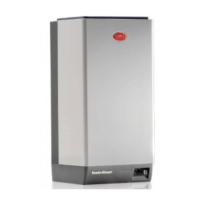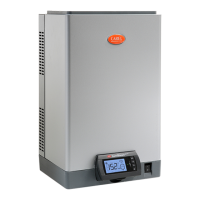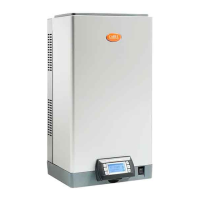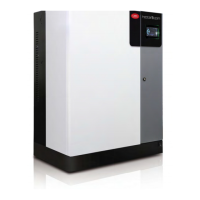8
ENG
“Ultrasound for fancoil” +0300059IE - rel. 1.7 - 24.10.2022
3.8 Fastening
Fastening instructions:
1. make two holes (gure)
2. x the fastening bracket using two M4x12 screws supplied, using a
spirit level to make sure installation is horizontal;
92
Ø 3.50
Ø 3.50
(110)
>200 mm
Fig. 3.e
Fig. 3.f
3.9 Structure
The gure shows the structure of the humidier with 1 piezoelectric
transducer (0.5 l/h)
3
4
5
11
10
3
9
6
1
5
8
7
6
Fig. 3.g
Key
1 Atomised water outlet 7 Auxiliary card
2 Signal LED 8 Main board
3 Fan 9 Piezoelectric transducer driver card
4 Tank 10 Piezoelectric transducer
5 Drain valve 11 Level sensor (internal)
6 Fill valve
3.10 Operating principle
The operation of humiSonic humidi ers is based on the principle of
atomisation of demineralised water using ultrasound technology. The
humidier operating principle can be summarised as follows:
• water ll via a ll solenoid valve until reaching the required level,
measured by the oat;
• if the autotest is enabled (default), the drain solenoid valve opens and
empties the tank (function designed to clean the tank of any residues/
dirt);
• water lled again to the required level;
• start ultrasonic atomisation (the fans installed on the humidier expel
the particles of moisture and distribute them into the surrounding
environment);
• water rell based on the oat measures that the level has fallen below
the recommended value.
Ultrasound technology uses a voltage input signal that is transformed
via an oscillating circuit into a high frequency signal (1.7 MHz). This signal
supplies a transducer, the top of which is in contact with the water, which
starts vibrating at high frequency. The surface of the transducer vibrates
at very high speed (1.7 million times a second), a speed that does not
allow the water to move, due to its inertial mass. Consequently, a column
of water is created above the transducer. During the negative amplitude
of the transducer cycle, a void is created that is not lled by the water (as
this cannot respond to the extremely fast movements of the transducer).
The cavity thus created leads to the production of bubbles that are
pushed to the edge of the water column during the positive amplitude of
the cycle, thus colliding. During this process, very ne particles of water
are atomised on the edge of the water column. The resulting intersecting
sound waves created directly underneath the surface of the water cause
very small droplets of water to separate, forming a ne mist of water that
is immediately absorbed by the ow of air.
After switching on
Transducer
Negative amplitude
Vacum
Transducer
Positive amplitude
Transducer
Fig. 3.h
